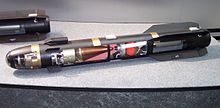AGM-114 Hellfire: Difference between revisions
Undid revision 146414204 by 203.67.195.44 (talk) |
|||
| Line 67: | Line 67: | ||
==Users== |
==Users== |
||
*{{flag|Australia}} |
*'''{{flag|Australia}} |
||
*{{flag|Egypt}} |
*'''{{flag|Egypt}} |
||
*{{flag|Greece}} |
*'''{{flag|Greece}} |
||
*{{flag|Israel}} |
*'''{{flag|Israel}} |
||
*{{flag|Italy}} |
*'''{{flag|Italy}} |
||
*{{flag|Netherlands}} |
*'''{{flag|Netherlands}} |
||
*{{flag|Norway}} |
*'''{{flag|Norway}} |
||
*{{flag|Singapore}} |
*'''{{flag|Singapore}} |
||
*{{flag|Sweden}} |
*'''{{flag|Sweden}} |
||
*{{flag|Taiwan}} |
*'''{{flag|Taiwan}} |
||
*{{flag|Turkey}} |
*'''{{flag|Turkey}} |
||
*{{flag|United Kingdom}} |
*'''{{flag|United Kingdom}} |
||
*{{flag|United States}} |
*'''{{flag|United States}} |
||
==Specifications== |
==Specifications== |
||
Revision as of 23:47, 22 July 2007
Template:Weapon-missile AGM-114 HELLFIRE II is a multi-platform, multi-target U.S. modular missile system.
Overview
HELLFIRE is an active radar guided missile which was initially designed to be primarily used as a "tank-buster", launched from helicopters to defeat armored vehicles. It has since matured to be a comprehensive weapon system that can be deployed from rotary- and fixed-wing aircraft, naval assets and land-based systems against a variety of targets.
HELLFIRE II, developed in the early 1990’s is a modular missile system with four variants for maximum battlefield flexibility. HELLFIRE II’s semi-active laser variants (AGM-114K high-explosive anti-tank [HEAT], AGM-114M [blast fragmentation], and AGM-114N metal augmented charge [MAC]) achieve pinpoint accuracy by homing in on a reflected laser energy beam aimed at the target from the launching platform. The AGM-114L, or Longbow HELLFIRE, is a fire-and-forget weapon: equipped with a millimeter wave (MMW) radar seeker, it requires no further guidance after launch and can hit its target without the launcher being in line of sight of the target. It also provides capability in adverse weather and battlefield obscurants.
HELLFIRE II (along with the Maverick) was to be replaced by the Joint Common Missile (JCM) around 2011. The JCM was developed with a tri-mode seeker and a multi-purpose warhead that would combine the capabilities of the several Hellfire variants. In the budget for FY2006, the US Department of Defense canceled a number of projects that they felt no longer warranted continuation based on their cost effectiveness, including the JCM, although some military and industry sources have produced data showing JCM is the most cost-effective way of adding performance across multiple platforms to meet projected threat growth on a timely basis. A possible new procurement for a JCM successor called the Joint Air to Ground Missile (JAGM) is under consideration. Due to the U.S. military's continuing need for a proven precision-strike aviation weapon in the interim until a successor to the JCM is fielded, as well as extensive foreign sales, it is likely the Hellfire will be in service for many years.
Combat history
Since being fielded, HELLFIRE missiles have proven their effectiveness in combat in Operation Just Cause in Panama, Operation Desert Storm, Operation Allied Force in Kosovo, Operation Enduring Freedom in Afghanistan, and most recently, Operation Iraqi Freedom—where they have been fired successfully from Apache and Cobra attack helicopters, Kiowa scout helicopters, and Predator unmanned aerial vehicles (UAVs). The Israeli Defence Forces have used them extensively against Palestinian targets.
Launch vehicles and systems

- A-10 Thunderbolt II
- AH-1W Cobra
- AH-64 Apache
- Agusta A129 Mangusta
- Eurocopter Tiger ARH
- Combat Boat 90
- SH-60B Seahawk
- HH-60H Seahawk
- MH-60R Seahawk
- OH-58D Kiowa Warrior
- P 6297 Hellfire Missile Boat
- Portable Ground Launch System
- RAH-66 Comanche
- MQ-1B Predator
- MQ-9 Reaper
- UH-60 Blackhawk
- Westland WAH-64 Apache
The system has been tested for use on the High Mobility Multipurpose Wheeled Vehicle (HMMWV) and the Improved TOW Vehicle (ITV). Test shots have also been fired from a C-130 Hercules (see photos below). Sweden and Norway use the Hellfire for coastal defense, and Norway has conducted tests with Hellfire launchers and aiming stations mounted on the Stridsbåt 90 coastal assault boat[1].
Users
 Australia
Australia  Egypt
Egypt Greece
Greece Israel
Israel Italy
Italy Netherlands
Netherlands  Norway
Norway Singapore
Singapore  Sweden
Sweden  Taiwan
Taiwan Turkey
Turkey United Kingdom
United Kingdom  United States
United States
Specifications
- Contractors: Rockwell International Corporation, Lockheed Martin, Northrop Grumman
- In May 1995, Martin Marietta (now Lockheed Martin) and Rockwell International (now part of Boeing Integrated Defense Systems) formed a joint venture – HELLFIRE Systems, Limited Liability Company (HSLLC) – to market and produce HELLFIRE missiles worldwide. The joint venture does not extend to Lockheed Martin’s Longbow HELLFIRE, where the company is in a joint venture with Northrop Grumman, nor to HELLFIRE II, where Lockheed Martin performs all work scope on behalf of HSLLC
- Diameter: 17.8 cm (7 in)
- Wing span: 71 cm (28 in)
- Velocity: 425 m/s (950 mph)
- Minimum range: 0.5 km
Variants
AGM-114A Basic Hellfire
- Target: Tanks, armored vehicles.
- Range: 8,000 m (8,750 yd)
- Guidance: Semi-active laser homing (SALH).
- Warhead: 8 kg (18 lb) shaped charge HEAT.
- Length: 163 cm (64 in)
- Weight: 45 kg (99 lb)
AGM-114B/C Basic Hellfire
- M120E1 low smoke motor.
- AGM-114B has electronic SAD (Safe/Arming Device) for safe shipboard use.
- Unit cost: $25,000
AGM-114D/E Basic Hellfire
- Proposed upgrade of AGM-114B/C with digital autopilot—not built.
AGM-114F Interim Hellfire
- Target: Tanks, armored vehicles.
- Range: 7,000 m (7,650 yd)
- Guidance: Semi-active laser homing.
- Warhead: 9 kg (20 lb) tandem shaped charge HEAT.
- Length: 180 cm (71 in)
- Weight: 48.5 kg (107 lb)
AGM-114G Interim Hellfire
- Proposed version of AGM-114F with SAD—not built.
AGM-114H Interim Hellfire
- Proposed upgrade of AGM-114F with digital autopilot—not built.
AGM-114J Hellfire II
- Proposed version of AGM-114F with lighter components, shorter airframe, and increased range—not built.
AGM-114K Hellfire II

- Target: All armored threats
- Range: 8 km (8,749 yd)
- Guidance:
- Semi-active laser homing
- Digital autopilot
- Electro-optical countermeasures hardening
- Target reacquisition after lost laser lock
- New electronic SAD
- Warhead: 9 kg (20 lb) tandem shaped charge HEAT
- Length: 163 cm (64 in)
- Weight: 45 kg (99 lb)
- Unit cost: $65,000
- Essentially the proposed AGM-114J w/ SAD
AGM-114L Longbow Hellfire
- Target: All armored threats
- Range: 8 km (8,749 yd)
- Guidance:
- Fire and forget
- Capability in adverse weather and battlefield obscurants
- Inertial guidance
- Millimeter wave radar seeker
- Home-on-jam anti-radiation mode
- Warhead: 9 kg (20 lb) tandem shaped charge high explosive anti-tank (HEAT)
- Length: 176 cm (69.2 in)
- Weight: 49 kg (108 lb)
AGM-114M Hellfire II
- Target: Bunkers, light vehicles, urban (soft) targets and caves
- Range: 8 km (8,749 yd)
- Guidance:
- Semi-active laser homing
- Warhead: Blast fragmentation/incendiary
- Weight: 48 kg (105 lb)
- Length: 163 cm (64 in)
AGM-114N Hellfire II
- Target: Enclosures, ships, urban targets, air defense units
- Range: 8 km (8,749 yd)
- Guidance:
- Semi-active laser homing
- Warhead: Metal augmented charge (MAC)
- Weight: 48 kg (105lb)
- Length: 163 cm (64 in)
AGM-114P Hellfire II
- Version of AGM-114K optimized for use from UAVs flying at high-altitude.
Rocket motor

- Contractor: Alliant Techsystems
- Designation:
- M120E3 (Army)
- M120E4 (Navy)
- Main features:
- Qualified minimum smoke propellant
- Rod and tube grain design
- Neoprene bondline system
- Performance:
- Operating temperature: −43 °C to 63 °C (−45 °F to 145 °F)
- Storage temperature: −43 °C to 71 °C (−45 °F to 160 °F
- Service life: 20+ years (estimated)
- Technical data:
- Weight: 14.2 kg (31.3 lb)
- Length: 59.3 cm (23.35 in)
- Diameter: 18 cm (7.0 in)
- Case: 7075-T73 aluminum
- Insulator: R-181 aramid fiber-filled EPDM
- Nozzle: Cellulose phenolic
- Propellant: Minimum smoke cross linked double based (XLDB)
Photos
-
Tank strike
-
C-130 test
-
AH-64
See also
- Brimstone missile - British fire and forget development of Hellfire
- Euromissile HOT
- Trigat
- List of missiles
- U.S. Army Aviation and Missile Command
- AN/PAQ-1
- Direct Attack Guided Rocket
References
- ^ Norwegian article about the experimental deployment of Hellfire missiles on coastal patrol boats (from the official web site of the Norwegian Armed Forces)
External links
- Anti-tank missiles
- Modern anti-tank missiles
- Modern American anti-tank missiles
- Modern American air-to-surface missiles
- Military equipment of Turkey
- Weapons of Norway
- Anti-tank missiles of the United States
- Anti-tank missiles of the United Kingdom
- Anti-tank missiles of Australia
- Anti-tank missiles of Egypt
- Anti-tank missiles of Israel
- Anti-tank missiles of Norway
- Anti-tank missiles of Singapore
- Anti-tank missiles of Sweden
- Cold War anti-tank missiles
- Gulf War guided missiles
- Iraq War guided missiles
- Cold War weapons



